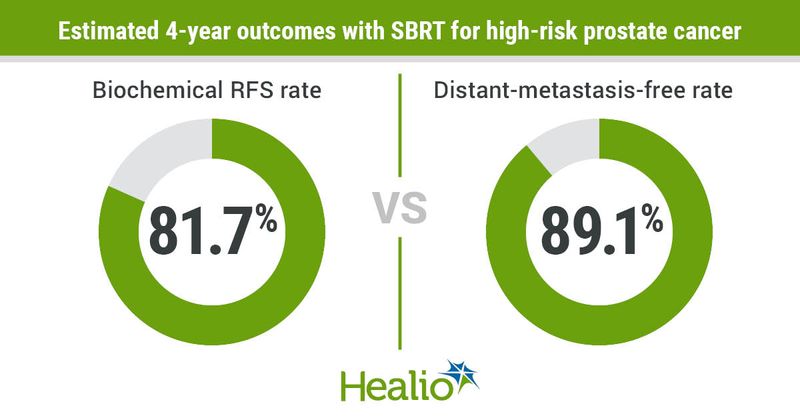Shorter, stronger radiation course effective for high-risk prostate cancer
Stereotactic body radiotherapy appeared safe and effective for men with high-risk prostate cancer, according to an analysis of data from a consortium of seven institutional phase 2 studies and registries.
The analysis, published in International Journal of Radiation Oncology, Biology, Physics, showed that the 5-day regimen of higher-dose radiotherapy had a 4-year cure rate of 82%.

“These findings suggest that stereotactic body radiotherapy, which condenses radiation treatment for prostate cancer into as few as four to five sessions (compared with 20-45 sessions previously), is safe and effective in a broad setting for patients with high-risk prostate cancer,” Amar U. Kishan, MD, assistant professor of radiation oncology at David Geffen School of Medicine at UCLA, told Healio. “This has previously been shown in patients with low- and intermediate-risk prostate cancer, but extending these findings to high-risk prostate cancer broadens applicability to many patients.”

Undertaken in an effort to help improve the overall quality of life for men with prostate cancer, the study by Kishan and colleagues was the largest data set to date examining this shorter course of radiation among men with more aggressive disease, according to a press release.
The analysis included data of 344 men (median age, 72.3 years) with high-risk prostate cancer.
Biochemical RFS and distant metastasis-free survival, assessed using the Kaplan-Meier method, served as the study’s primary outcomes.
Researchers also used logistic regression model to evaluate associations between acute and late grade 2 or worse genitourinary and gastrointestinal toxicity and age, dose per fraction, androgen deprivation therapy use and nodal radiotherapy.
Each patient had a minimum follow-up of 24 months (median follow-up, 49.5 months).
Overall, 72% of men received ADT (median duration, 9 months) and 19% received elective nodal radiotherapy.
The estimated 4-year biochemical RFS rate was 81.7% (95% CI, 77.2-86.5) and the distant-metastasis-free rate was 89.1% (95% CI, 85.3-93.1).
Results of a multivariable competing risk analysis showed risk for biochemical recurrence was associated with 7 Gy vs. 8 Gy per fraction (subdistribution HR [sHR] = 2.15; 95% CI, 1.07-4.32), natural log initial PSA (sHR = 1.42; 95% CI, 1-1.08) and 1-year increase in age at treatment (HR = 1.04; 95% CI, 1-1.07). Researchers observed no significant predictors of time to distant metastasis.
Also, men who received ADT had lower incidence of biochemical recurrence (P = .017), but incidence of distant metastasis did not differ according to ADT receipt.
Eighteen percent of men experienced grade 2 or worse genitourinary toxicities and 5% experienced grade 2 or worse gastrointestinal toxicities.
Dose per fraction of 7.25 Gy vs. 8 Gy appeared associated with lower odds of late grade 2 or worse genitourinary (OR = 0.09; 95% CI, 0.02-0.48) and gastrointestinal toxicity (OR = 0.28; 95% CI, 0.11-0.56), whereas ADT increased odds of late grade 2 or worse toxicity (genitourinary, OR = 4.09; 95% CI, 1.25-13.4; gastrointestinal, OR = 4.34; 95% CI, 1.68-11.2).
Additionally, researchers reported crude incidences of 2.3% for late grade 3 or worse genitourinary toxicity and 0.9% for gastrointestinal toxicity.
These data demonstrate efficacy of SBRT for high-risk prostate cancer, according to Kishan and colleagues. They added that the 4-year biochemical RFS rate observed in their study appeared similar to the 5-year rates among men in the ASCENDE-RT trial who received a brachytherapy boost (85.5%) or dose-escalated conventionally fractionated radiotherapy alone (83.6%) along with 12 months of ADT, despite that some men in the current trial received no or shorter courses of ADT.
Researchers also noted the low toxicity rates were consistent with the prior SBRT reports for low- and intermediate-risk prostate cancers.
The researchers acknowledged the nonrandomized nature of the study and relatively short follow-up, given the long natural history of prostate cancer, as limitations of their analysis.
There are “several intriguing avenues” for additional research on this topic, Kishan told Healio.
“First and foremost, large randomized trials, such as the PACE-C randomized trial run out of the United Kingdom, will be critical to cement SBRT as the standard option, as opposed to a standard option, so we eagerly await that,” Kishan said.
“Second, multiple studies are ongoing to find out how we can best optimize treatment in patients with more aggressive features, perhaps by adding drugs or selectively increasing dose, and de-escalate treatments in patients with less aggressive features, perhaps by doing the opposite,” he added. “Third, technological advances, such as direct MRI-guided radiotherapy, may help us improve the precision of this treatment further and are being actively studied.”
For more information:
Amar U. Kishan, MD, can be reached at aukishan@mednet.ucla.edu.
